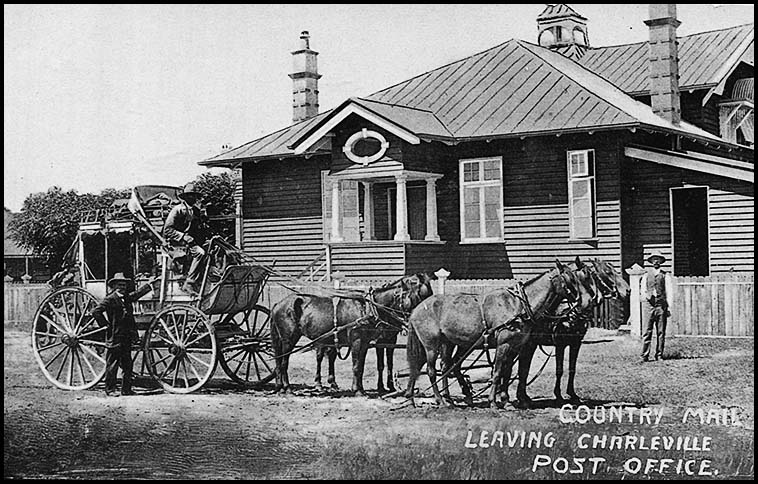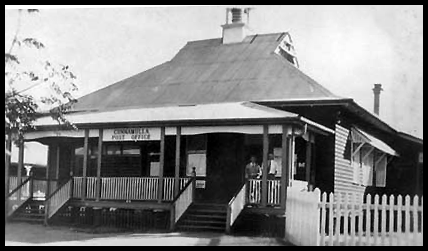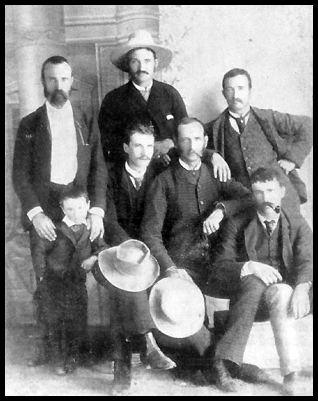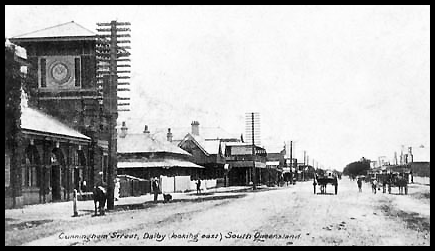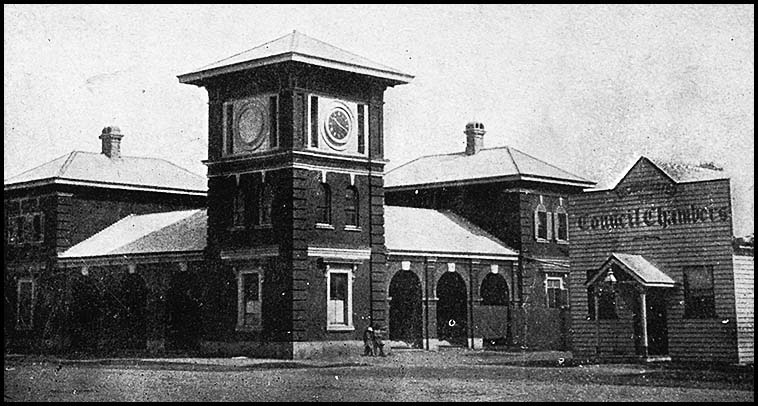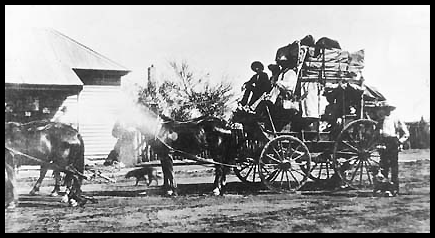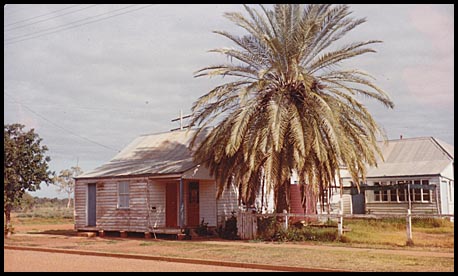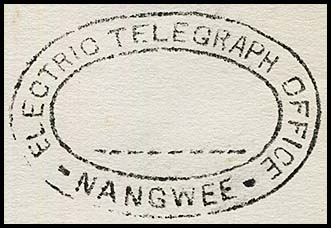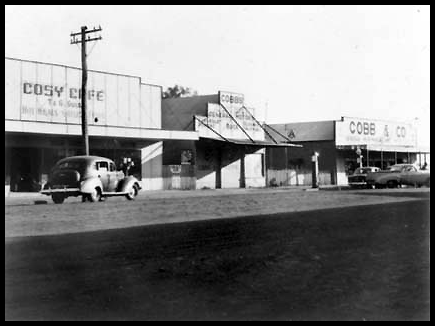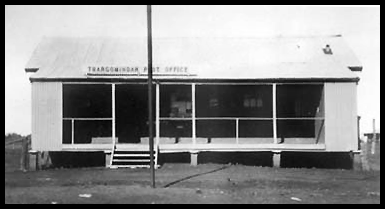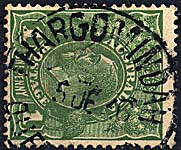Telegraph Offices in the South West region.
- Australia 1901-1988
- New South Wales
- Overview of NSW
- Telegraph lines
- Telegraph Offices
- Date stamps
- Forms
- Envelopes
- Instructional annotation
- Collect
- Delayed
- Free
- Immediate Urgent
- Reply paid
- Rates
- Stamps
- 1871 Telegraph stamps
- 1885 proposal
- 1893 proposal
- Queensland
- South Australia
- Tasmania
- Victoria
- Western Australia
- International
- Special aspects
The following Telegraph Offices located in the South West region of Queensland are included in this page:
|
A Telegraph Office was opened for public business at the Railway Station in December 1884. |
| Charleville.
The Telegraph Office opened on 5 October 1874. It was a designated repeater station. In 1880, 3,401 messages were sent including 420 OHMS messages. The staff of the Telegraph section consisted of one Electric Telegraph Station Master, one operator, one line repairer and one messenger. In 1922, QANTAS began its first regular flights from Charleville. |
||
|
||
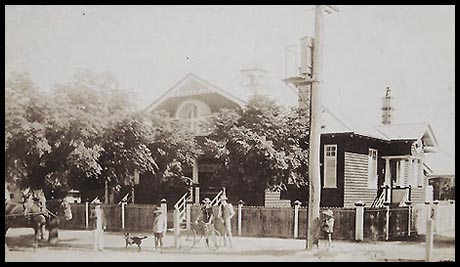 Charleville Post and Telegraph Office about 1910. |
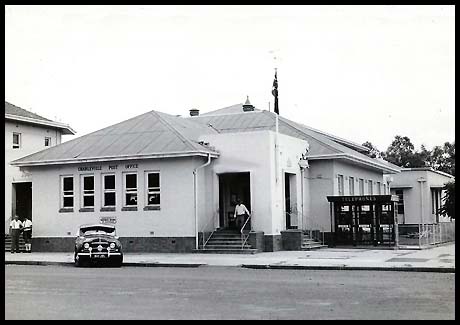 The modern version of the Charleville Post Office. |
|
| In 1889, Mr. P. E. G. Luny was the Post and Telegraph Master at Charleville. Unfortunately, he broke the most sacrosanct law of any Telegraph Office - he disclosed the contents of a telegram (to his housekeeper while she was cooking him breakfast). Sometimes a big mouth cannot be quietened. Read about the incident and the trial in the Newcastle Morning Herald of 10 January 1890. | ||
| Clintonvale R.S.
The Telegraph Office appears to have been opened at the Railway Station. |
||
A Format 3 - BO3-ETO date stamp was issued to the Office.
|
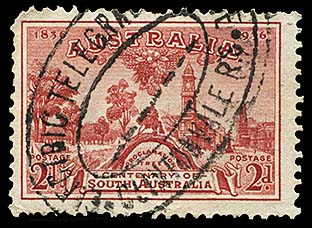 |
|
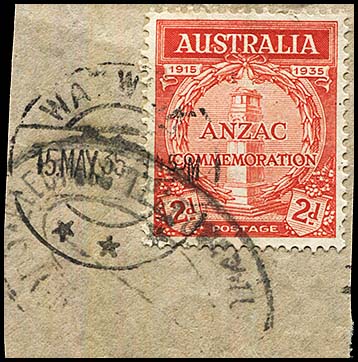 About 15 May 1935. |
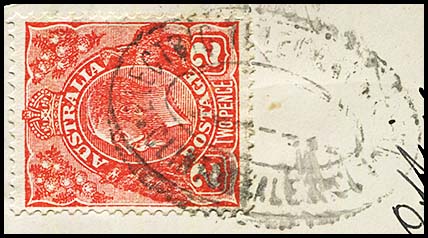 |
|
|
Dirranbandi is south of St George and just above Hebel on the NSW Border. The Telegraph Office opened in XXX but closed on 30 June 1887. It re-opened on 5 October 1888. The Gazette had two relevant notifications:
The Post and Telegraph Guide for June 1889 listed a Post Office as being established at Dirranbandi. |
|
| No special date stamp for telegraph use was issued to Dirranbandi. Instead the usual postal date stamp was used. | 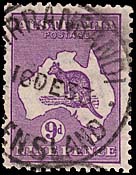 16 December 1937. 9d would have paid the basic rate for a telegram sent within a radius of 15 miles. |
|
Although the date stamp is inscribed DRUM RANGE, it is probable that the name of the locality was DRUMMOND RANGE and that the abbreviation was used to fit the space available on the date stamp. That location is north of a point about midway between Alpha and Emerald. |
|
| A special date stamp was issued to the Office and it has a most unusual format.
The letters in front of DRUM RANGE are T.O.K. meaning Telegraph (or Telephone) Office Keeper. Drum Range is the only known office in Queensland which had such an inscription. Isolated examples are also recorded for Lalalty (NSW) and for Victoria. |
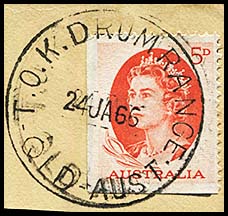 24 January 1966 - 3 weeks before decimal currency was introduced. |
|
|
|
Flagstone Creek is located about 10 miles east from Toowoomba. A silver mine operated there in the 1890s with about 8 tons of silver being sent to Footscray via Aramac each day. It is now on the Beaudesert - Tambourine-Beenleigh Road. The Brisbane Courier of 3 January 1891 reported:
Details about post and telegraph services are incomplete. A Receiving Office was opened on 1 January 1887 with a Post Office opened in January 1909. That Office closed on 28 August 1929. |
||
It is not known if the Post Office had telegraph facilities. The two date stamps shown here indicate some type of postal office was operating in the 1960s and 1970s - perhaps with telegraphic facilities. |
 18 October 1967. |
 19 December 1972. |
|
In the Gazette of 22 February 1879, a one acre reserve block was set aside for a Telegraph Office at Harrisville. |
|
Hebel is about 4 km north of the border between Queensland and New South Wales. Curriwillinghi Post Office opened on 1 January 1864 - named after the Curriwillinghi pastoral station which is still operating. It was renamed Hebel Post Office in 1889. During the 2020-21 Covid-19 pandemic, the Queensland Police operated a border crossing check-point at Hebel. |
|
The Telegraph Office opened on 22 August 1878. |
|
| A circular steel postal date stamp was used on telegrams at Wynnum:
Used in blue: 28 February 1903. Size: 22 × 30 mm (e = 0.68). Rated: RRRR. Number in the Census: 1. |
 25 February 1949. Used on AW-DO-10D (47). |
|
Mitchell Downs - renamed to Mitchell - is east of Charleville. On 5 October 1874, the line was complete but it was not until 16 November 1878 that the Telegraph Office was opened. The Brisbane Courier of the 30th reported "Our new telegraph office is completed; as to situation and design, it is a mere matter of taste. However, the workmanship is good and creditable to the contractor. Mr. Scott, the telegraph master, inspected on the 14th instant, and took possession on the 15th. There is only one officer here and, as he has to do the duty of line repairer, the office is very often closed - to the inconvenience of the public". |
| Mount Morgan.
The Telegraph Office |
|
 Mount Morgan Post & Telegraph Office in 1911. The Telegraph Office is advertised above the left door. |
|
|
Mount Sturt is east of Warwick. It is named after the nearby mountain. In mid-1884, the railway line from Warwick incorporated a railway station on its way to Emu Vale. That station closed in May 1964. |
|
The image came from a Queensland Railway Commmissioner's file. See also listing of Queensland ETO Ovals. ETO Oval: Format 5.
|
 No date. Only recorded image - courtesy of Dave Elsmore of Queensland. |
| Mungindi (see NSW listing). |
|
The office was opened in ??. Nangwee is south of Dalby and Bowenville which are on the line from Toowoomba to Dalby. The Office was issued with a BO3 - ETO date stamp.
|
|
|
Quinalow is about 30 kms north-east of Dalby and north of Jondaryan. The township was established in 1889. A Receiving Office was opened in February 1893 and that was upgraded to a Post Office in 1904. It reverted to a Receiving Office in about 1923 before being reclassified as a Telegraph Office in 1924. The Office was closed in 1941. In May 1909, a new 2 mile telegraph line between Quinalow and Cooyar was completed with Offices in both places being opened on 16 May. The Daly brothers, who had established the area, were conditionally given a licence to construct a butter and cheese factory there in September 1894. In May 1907, Mr. J. J. Daly was refused a licence to open a hotel on the grounds that Quinalow did not need a second hotel. Between 1948 and 1996, it again operated as a Post Office. The Dalby Herald of 17 August 1948 reported:
|
|
The Office was issued with the usual Commonwealth-type postal date stamp for use with telegrams.
|
 3 October 1929. Largely fine slightly doubled strike on WA Centenary 1½d Swan. |
|
The Telegraph Office opened on 17 November 1866. Roma was an officially designated Repeating Station. In 1880, 11,138 messages were sent including 1,498 OHMS messages. The staff of the Telegraph section consisted of one Electric Telegraph Station Master, 2 operators, 1 line repairer, 1 clerical assistant and one messenger. |
|
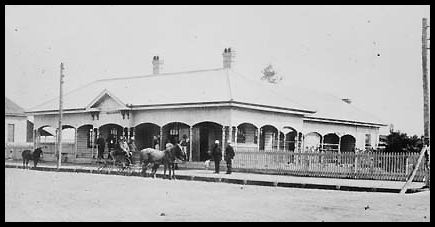 Roma P&T taken about 1875. Note telegraph poles. Source: Australian National Archives J2879 QTH631. |
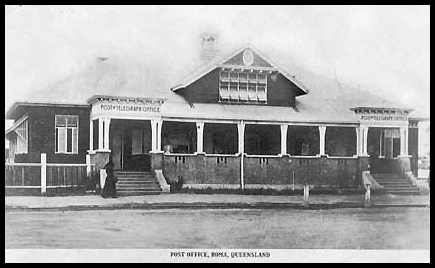 Roma P&T about 1920 after modernisation. Source: Australian National Archives J2879 QTH328. |
|
The Telegraph Office opened on 2 December 1874. The Dalby Herald of 9 January 1876 provided the following update on the operation of the St. George Telegraph Office: "The business of the Telegraph Office is going on in a very satisfactory manner and, I believe, its receipts can compare favorably with those of many more pretentious inland towns in the colony. It has been found necessary by the heads of the department, on account of pressure of business, to place this office in direct communication with the head office in Brisbane, instead of having messages repeated from Roma. One gentleman has informed me that he has sent a message right away to London and considers it something to "blow" about. I'm not much of a judge on these matters, but I think so too". In 1880, 5,167 messages were sent including 312 OHMS messages. The staff of the Telegraph section consisted of one Electric Telegraph Station Master and one line repairer. |
|
Stockyard Creek is south east of Toowoomba between Helidon and Warwick. |
|
A steel oval Electric Telegraph Office was issued to Gatton.
|
 |
| No special date stamp was issued to the office for use with telegrams after the name changed from Stockyard Creek to Stockyard. |  24 May 1967. |
|
A Post Office was opened about 1911. Located between Goondiwindi and Inglewood. The name means "a large lagoon adjacent to a Station". |
|
There is no record of a telegraph date stamp being issued to Yuleba. Two postal date stamps used on telegrams are included here: Format 1:
|
 12 April 1937. Used on AB-DO-8F. |
Format 2:
|
 19 November 1946. Used on AW-DO-10C. |
|
Yuleba was established in 1878 and was connected to the railway in 1879. As a railhead for the region to the west, the town was an important centre until the railway was extended again to Roma in 1910. Due to an error in assembling a sign for the railway station - and therefore for the telegraph - the station and the town were originally known as Yeulba. In 1938, the name was changed to the original intended name of Yuleba meaning "place of the waterlillies". On 16 August 1924, the last Cobb and Co stage coach ran between Yuleba and Surat. |
|
There is no record of a telegraph date stamp being issued to Yuleba. For the postal date stamp shown here (with the original mis-spelling):
|
 30 April (?) 1920. |
